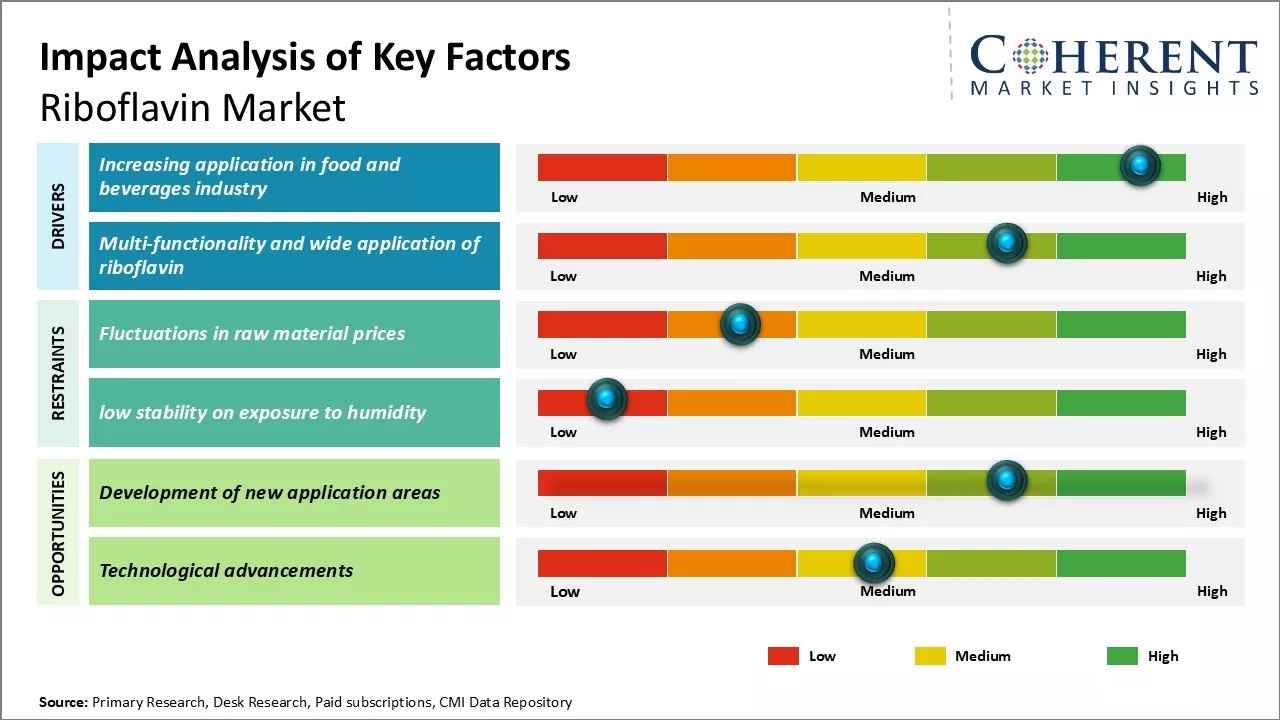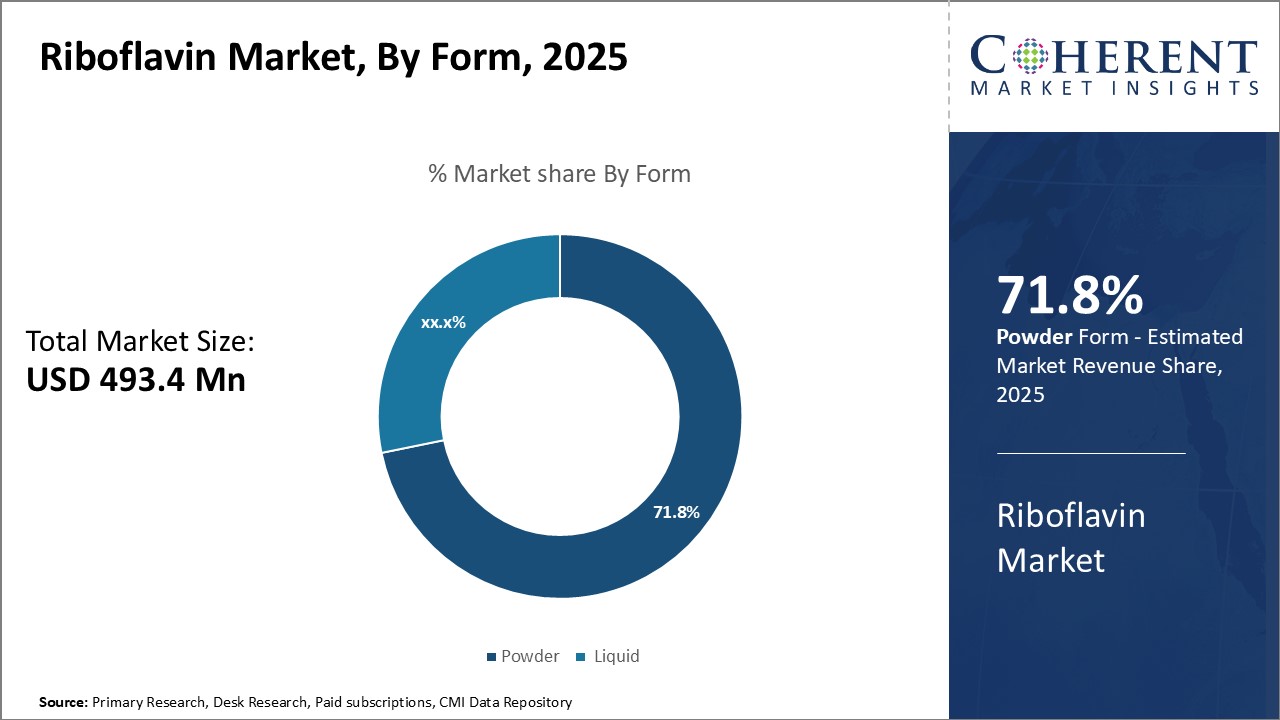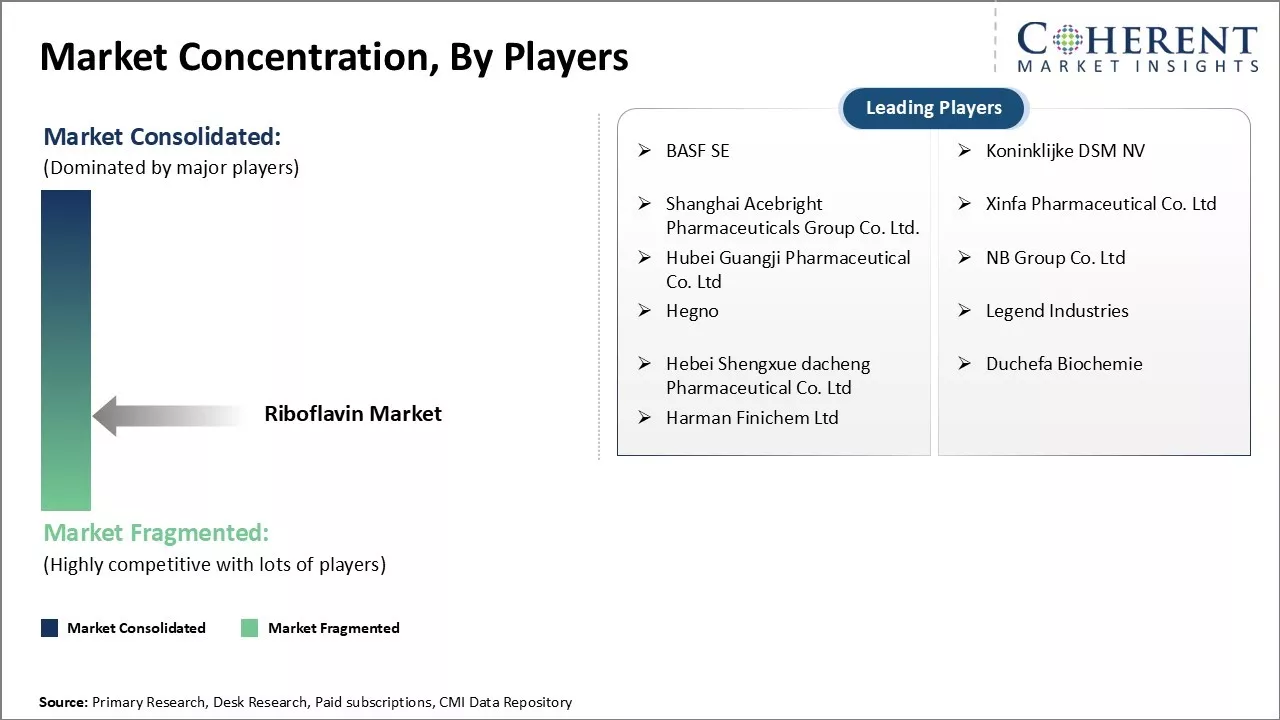Riboflavin market is estimated to be valued at USD 493.4 Mn in 2025 and is expected to reach USD 787.6 Mn by 2032, exhibiting a compound annual growth rate (CAGR) of 6.9% from 2025 to 2032.

Discover market dynamics shaping the industry: Download Free Sample
The riboflavin market is expected to witness positive growth over the forecast period. Rising health consciousness among individuals and focus on balanced nutrition and supplements are driving the sales of riboflavin. In addition, increasing expenditure on functional food and beverages incorporated with vitamins and minerals is supporting the market growth. Growing use of riboflavin in animal feed to enhance meat quality is another factor propelling the demand for riboflavin. Furthermore, rising cases of vitamin B2 deficiency across populations is prompting manufacturers to fortify various food products with riboflavin, thus fueling market expansion.

Discover high revenue pocket segments and roadmap to it: Download Free Sample
Insights, By Form- Convenience and shelf-life drive powder form dominance.
In terms of form, powder segment is estimated to contribute the highest market share of 71.8% in 2025, owing to its convenience and longer shelf life as compared to liquid forms of riboflavin. Powdered riboflavin is lightweight and compact, thus, making it versatile for transportation and storage across supply chains. Its dry form does not require refrigeration, keeping production and logistics costs low. This durable nature enables easier inventory management for manufacturers and retailers. Powder dissolves quickly in liquid, dissolving any clumps easily for smooth incorporation into food and beverage products. Its non-perishable nature reduces food waste and spoilage as compared to liquid riboflavin. These compelling advantages have made powder the preferred consumption format, thus, driving its popularity among food companies and dietary supplement manufacturers.
Insights, By Source- Plant sources dominate riboflavin production due to sustainability and cost advantages.
In terms of source, plant segment is estimated to contribute the 58%, market share in 2025, as plant-derived riboflavin is more sustainable and economical to produce at scale. Riboflavin (vitamin B2) is naturally found in a wide variety of plants such as mushrooms, legumes, grains and green vegetables. Advanced agricultural technologies have optimized high-yield plant varieties and farming methods to produce riboflavin in bulk. Plant sources does not require artificial growing conditions or processing as with some microbial and animal sources. These are more environmentally-friendly as production relies on natural sunlight and soil-based agriculture. The minimal energy and infrastructure needs for plant-sourced riboflavin give it a lower carbon footprint. Its relatively low production costs have made plant-derived riboflavin highly attractive to price-conscious consumer markets.
Insights, By Application- Food and beverages dominate riboflavin applications due to its importance in human diets.
In terms of application, food and beverages segment is estimated to contribute the 59%. market share in 2025. Riboflavin plays a critical nutrient role as a cofactor in metabolic enzymes and for energy production in the human body. Its bright yellow color also acts as a natural food coloring or supplement used widely in breads, cereals, dairy products, supplements, and plant-based alternative milks. This ensures basic nutritional needs are easily met without requiring purposeful supplementation habits. It has especially benefited developing regions where malnutrition risks are higher. The natural fit and mass consumption of fortified food products has made the food and beverage industry the largest end user of riboflavin globally.

Need a Different Region or Segment? Download Free Sample
Regional Analysis- Riboflavin Market
Dominating Region- Asia Pacific
Asia Pacific is expected to dominate the riboflavin market with an estimated market share of 35.8% in 2025, due to presence of pharmaceutical and food & beverage industries in the region. High per capita income and standards of living have boosted consumer demand for nutrient-rich processed foods and medicines.
Fastest-Growing Region- North America
North America exhibits the fastest growth due to rising incomes, expanding population sizes, and increasing health awareness in developing countries.
Riboflavin Market Outlook for Key Country
U.S.- The U.S. riboflavin market is characterized by the domination of major players. Companies such as DSM and BASF leverage the country's advanced manufacturing infrastructure and skilled workforce.
Germany- Germany riboflavin market lead through its advanced scientific capabilities and strong pharmaceutical industry base represented by Merck and Bayer
China- China riboflavin market is gaining prominence with foreign manufacturers setting up local production units to serve rising local needs. This presents opportunities for international companies to partner with domestic firms.
India- India riboflavin market is at a nascent stage, though growing fast on the back of economic liberalization and young population demographics. Local players like Jubilant Life Sciences have emerged as strong regional competitors

Get actionable strategies to beat competition: Download Free Sample
Top Strategies Followed by Riboflavin Market Players
Emerging Startups in the Riboflavin Market
Several startups are bringing innovative solutions that could disrupt the riboflavin market. Synribo, a biotech startup, employs synthetic biology techniques to engineer riboflavin-overproducing microbial strains. This allows for more sustainable and scalable riboflavin production methods compared to traditionally used fungi and bacteria. Ribovia works on smart riboflavin biosensors integrated with IoT technologies. The biosensors measure riboflavin levels in real-time and can help optimize industrial fermentation processes as well as develop personalized nutrition solutions.
Some startups are pioneering sustainable approaches. Renewal uses food waste as a fermentation feedstock for producing riboflavin, contributing to waste utilization and circular bioeconomy efforts. ReFlour focuses on developing plant-based and vegan riboflavin sources for the growing market of natural food products. Its algal and plant extracts enriched with riboflavin could provide more environment-friendly alternatives. Such startups bring novel solutions addressing sustainability while partnering with larger industry players for tech.
Key Takeaways from Analyst
Riboflavin Market Report Coverage
| Report Coverage | Details | ||
|---|---|---|---|
| Base Year: | 2024 | Market Size in 2025: | USD 493.4 Mn |
| Historical Data for: | 2020 To 2024 | Forecast Period: | 2025 To 2032 |
| Forecast Period 2025 to 2032 CAGR: | 6.9% | 2032 Value Projection: | USD 787.6 Mn |
| Geographies covered: |
|
||
| Segments covered: |
|
||
| Companies covered: |
BASF SE, Koninklijke DSM NV, Shanghai Acebright Pharmaceuticals Group Co. Ltd., Xinfa Pharmaceutical Co. Ltd, Hubei Guangji Pharmaceutical Co. Ltd, NB Group Co. Ltd, Hegno, Legend Industries, Hebei Shengxue dacheng Pharmaceutical Co. Ltd, Duchefa Biochemie, and Harman Finichem Ltd |
||
| Growth Drivers: |
|
||
| Restraints & Challenges: |
|
||
Uncover macros and micros vetted on 75+ parameters: Get instant access to report
Market Driver- Increasing application in food and beverages industry
Riboflavin acts as a colorant and nutrient in various food products. Riboflavin is added to dairy products to enhance their appearance. The yellowish tint it provides to milk, cheese and yogurt makes them look fresh and healthy. This has increased its demand from dairy product manufacturers. According to the competitors, BASF SE Vitamin B2 (riboflavin) is an essential micronutrient naturally contained in eggs, meat and dairy products. Plant-derived foods such as nuts, vegetables and grains contribute small quantities to vitamin B2 intake.
Market Challenge- Fluctuations in raw material prices
Fluctuating prices of raw materials can pose challenges for market players. Riboflavin is derived from various natural sources such as eggs, meat, dairy products, and others. The prices of these raw materials tend to fluctuate frequently depending on various factors such as crop yields, demand and supply forces, weather conditions, global trade restrictions, and others. Any significant increase in the prices of raw materials puts an added cost pressure on riboflavin manufacturers. It becomes difficult for them to maintain stable profit margins in such a scenario. Manufacturers are forced to periodically increase the prices of riboflavin as well to offset the impact of rising raw material costs. Such price fluctuations can negatively impact the demand from price-sensitive end-use segments. The manufacturers have to constantly work on raw material procurement strategies and alternative sourcing options to mitigate this risk.
Market Opportunity- Development of new application areas
Riboflavin market can witness growth opportunities due to ongoing development of new application areas. Some of the notable application areas that are currently being explored include skin disease treatment, infertility treatment, cataract treatment, treatment of metabolic disorders, and others. For example, as per the recent studies conducted by Ministry of Science and Technology, India, riboflavin could be effectively used as a bio-fortification for staple crops to combat micro-nutrient deficiencies, which afflict over 2 billion people globally, according to the UN Food and Agriculture Organization. Rising demand for fortified foods due to increasing health consciousness can present a major tailwind for riboflavin producers. The companies operating in the riboflavin space need to dedicate more resources towards research collaborations with medical institutes and clinical research to explore new use cases. This will help boost the growth prospects of the market.
Share
Share
About Author
Yash Doshi is a Senior Management Consultant. He has 12+ years of experience in conducting research and handling consulting projects across verticals in APAC, EMEA, and the Americas.
He brings strong acumen in helping chemical companies navigate complex challenges and identify growth opportunities. He has deep expertise across the chemicals value chain, including commodity, specialty and fine chemicals, plastics and polymers, and petrochemicals. Yash is a sought-after speaker at industry conferences and contributes to various publications on topics related commodity, specialty and fine chemicals, plastics and polymers, and petrochemicals.
Missing comfort of reading report in your local language? Find your preferred language :
Transform your Strategy with Exclusive Trending Reports :
Frequently Asked Questions
Joining thousands of companies around the world committed to making the Excellent Business Solutions.
View All Our Clients